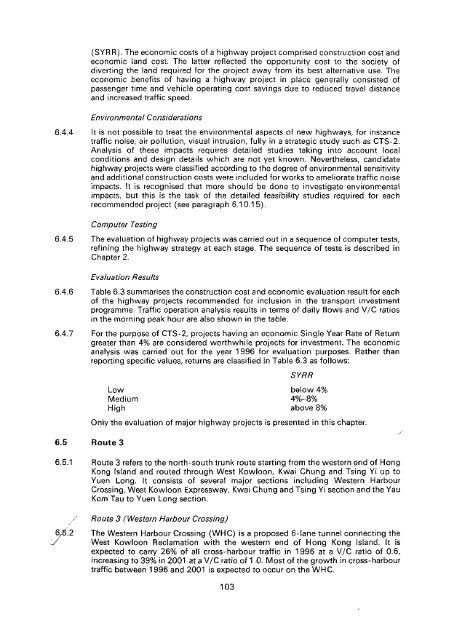Untitled - HKU Libraries - The University of Hong Kong
Untitled - HKU Libraries - The University of Hong Kong
Untitled - HKU Libraries - The University of Hong Kong
- No tags were found...
Create successful ePaper yourself
Turn your PDF publications into a flip-book with our unique Google optimized e-Paper software.
(SYRR). <strong>The</strong> economic costs <strong>of</strong> a highway project comprised construction cost andeconomic land cost. <strong>The</strong> latter reflected the opportunity cost to the society <strong>of</strong>diverting the land required for the project away from its best alternative use. <strong>The</strong>economic benefits <strong>of</strong> having a highway project in piace generally consisted <strong>of</strong>passenger time and vehicle operating cost savings due to reduced travel distanceand increased traffic speed.Environmental Considerations6.4.4 It is not possible to treat the environmental aspects <strong>of</strong> new highways, for instancetraffic noise, air pollution, visual intrusion, fully in a strategic study such as CTS-2.Analysis <strong>of</strong> these impacts requires detailed studies taking into account localconditions and design details which are not yet known. Nevertheless, candidatehighway projects were classified according to the degree <strong>of</strong> environmental sensitivityand additional construction costs were included for works to ameliorate traffic noiseimpacts. It is recognised that more should be done to investigate environmentalimpacts, but this is the task <strong>of</strong> the detailed feasibility studies required for eachrecommended project (see paragraph 6.10.15).Computer Testing6.4.5 <strong>The</strong> evaluation <strong>of</strong> highway projects was carried out in a sequence <strong>of</strong> computer tests,refining the highway strategy at each stage. <strong>The</strong> sequence <strong>of</strong> tests is described inChapter 2.Evaluation Results6.4.6 Table 6.3 summarises the construction cost and economic evaluation result for each<strong>of</strong> the highway projects recommended for inclusion in the transport investmentprogramme. Traffic operation analysis results in terms <strong>of</strong> daily flows and V/C ratiosin the morning peak hour are also shown in the table.6.4.7 For the purpose <strong>of</strong> CTS-2, projects having an economic Single Year Rate <strong>of</strong> Returngreater than 4% are considered worthwhile projects for investment. <strong>The</strong> economicanalysis was carried out for the year 1996 for evaluation purposes. Rather thanreporting specific values, returns are classified in Table 6.3 as follows:SYRRLow below 4%Medium 4%-8%High above 8%6.5 RouteSOnly the evaluation <strong>of</strong> major highway projects is presented in this chapter./6.5.1 Route 3 refers to the north-south trunk route starting from the western end <strong>of</strong> <strong>Hong</strong><strong>Kong</strong> Island and routed through West Kowioon, Kwai Chung and Tsing Yi up toYuen Long. It consists <strong>of</strong> several major sections including Western HarbourCrossing, West Kowioon Expressway, Kwai Chung and Tsing Yi section and the YauKom Tau to Yuen Long section.Route 3 (Western Harbour Crossing)6/5.2 <strong>The</strong> Western Harbour Crossing (WHC) is a proposed 6-lane tunnel connecting the'/ West Kowioon Reclamation with the western end <strong>of</strong> <strong>Hong</strong> <strong>Kong</strong> Island. It isexpected to carry 26% <strong>of</strong> all cross-harbour traffic in 1996 at a V/C ratio <strong>of</strong> 0.6,increasing to 39% in 2001 at a V/C ratio <strong>of</strong> 1.0. Most <strong>of</strong> the growth in cross-harbourtraffic between 1996 and 2001 is expected to occur on the WHC.103
















